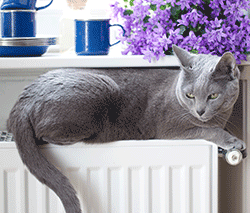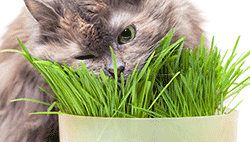Keeping a cat indoors
If you have chosen, or need, to keep your cat indoors there are some things you can do to replace any lost outdoor stimulation

Is it ok to keep a cat indoors?
Whilst some will argue that a cat should always be allowed outside there is no real harm in keeping a cat indoors for the duration of its life, which statistically will be longer than a cat allowed to roam free outdoors. In some cases indoor life is a necessity, if the cat is a disease carrier, old and infirm, blind, or living in an apartment. However, if your cat is to spend the rest of its life indoors, some provisions should be made to replace a few of the lost benefits of outdoor life.
Scratching
The wear and tear on the claws of an active outdoor cat helps to prevent them from getting too long or sharp and cats instinctively scratch at things to keep their claws in check. For an indoor cat there are no trees or fence posts to scratch on so they have to use other objects - like carpets, curtains, and furniture! You can only prevent your cats scratching things they shouldn't if they are given a better alternative so a scratching post or mat is a necessity.
Mental stimulation
Cats tend to spend most of their time sleeping, cleaning, and eating, but they also need plenty of mental stimulation. An outdoor cat will get much of this by simply exploring, finding new things, and practicing hunting (even if its just an ant or spider) An indoor cat has to deal with pretty much the same surroundings every day with very little change. In the long term this boredom can lead to frustration and behavioural problems such as aggression, scratching or innapropriate toileting.
You can encourage inquisitive behaviour by hiding food items around the house or inside items like bottles which will require some mind work to get out. Make sure you remember where you have put food to avoid any being left and going off! Occasionally opening up new areas, like a cupboard which is normally closed, can also help stimulate the mind, just make sure the cat can't get trapped anywhere.

Growing special grass for your cat aids health and stimulation
Grass
Cats outside can often be seen eating grass, this is not because it is tasty or nutritional (although it does contain folic acid) but because it helps aid a cat's digestive system and also helps in the production of hairballs. Quite often after eating grass your cat will vomit, this is because it cannot digest the grass easily, but this is a good thing as it helps to clear out your cats system of hair or any other debris. If your cat cannot eat grass it may be a good idea to grow some in the house for your cat to eat. You can purchase cat grass seeds at most pet shops, and these are normally the best varieties. Simply grow the grass in a shallow tray in an accessible area and your cat will soon discover it.
Play & activities
The easiest and best form of stimulation is play and to counter any boredom you should make time for regular interaction and playing with toys. Rotating toys around every few weeks so that they do not become routine can help (although favourite toys can be kept out all the time) Cat activity centres or activity 'trees' are also a good source of play stimulation and there are all sorts of styles around, although there is no guarantee your cat will use them. The use of catnip on occasion can help encourage the use of toys.
Fresh air, sunshine & windowsills
Indoor cats often spend a lot of time in windows watching the outside world. This does not necessarily mean they are longing to be outside but just that the window is an interesting place to be. Dogs, cars, and people passing by are especially interesting when safely behind glass, and birds flying around stimulate a cats mind. You should make sure your cat has easy access to a window where it can watch the outside world and also receive some natural sunlight. Providing fresh air is good for general health, but make sure any open windows are very narrow and impossible to get through.
Letting your cat out as a 'treat'
If its a nice sunny day, you may think it would be nice to let your cat outside for a while. If your cat does not regularly go outside, occasional outings like this can be very dangerous. If your cat were to get a bit adventurous and jump the fence, then encounter a shock such as another cat or dog, or even just a car passing by, it could quickly bolt and soon find itself lost in an unfamiliar place with no 'life-tools' to guide it through the strange sights and sounds. With some prior indoor training though, you could try and use a cat harness and lead and take the cat out for supervised walks in the garden. Make sure your cat is used to this situation before trying it outdoors.


